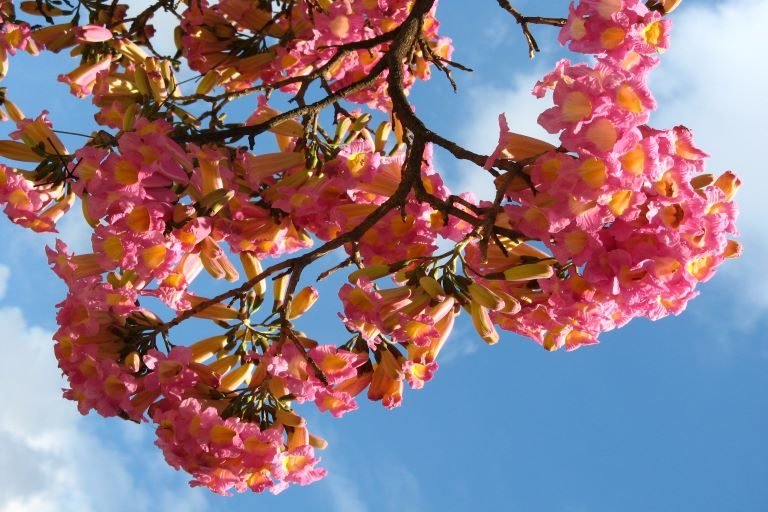- Demand for wood from ipê trees in the Amazon Basin could lead to their extinction if better international trade regulations aren’t implemented soon, according to a new report from Forest Trends.
- Ipê hardwood is in high demand in the luxury timber market, especially for outdoor boardwalks, decks and furniture, as well as hardwood floors.
- The Forest Trends report urges officials to list the rare species under CITES, the international convention regulating the trade of threatened species.
Whether walking along a beach boardwalk, installing new hardwood floors or sitting out on a friend’s deck, there’s a good chance you’ve already come across the wood of the rare ipê trees. These are among the most popular species supplying a global luxury wood market, an increasing driver of deforestation in the Amazon Basin.
Demand for the wood, combined with a lack of environmental trade protections, has pushed ipê trees close to extinction, according to a new report from Forest Trends. The report warns that if international regulations aren’t implemented soon, ipê may disappear from the Amazon altogether.
“Ipê populations have severely declined over the last 30 years,” the report said, “with growing concerns about their future.”
The name “ipê” refers to several remarkably similar tree genera, including Handroanthus, Tabebuia and Roseodendron, all of which have extremely hard woods that are resistant to rot, making them perfect for outdoor use. Around 96% of them are found in Brazil, with others spread throughout Paraguay, Bolivia, Peru and Ecuador.
Two of the ipê species, Handroanthus serratifolius and Handroanthus impetiginosus, are listed respectively as threatened and near threatened with extinction on the IUCN Red List.
At least 525 million kilograms (1.16 billion pounds) of wood from ipê trees was exported from the region between 2017 and 2021, the report said. Most of it went to the United States, Canada and Europe. Other exports went to Israel, China, South Korea, Japan and India.
Ipê trees grow extremely slowly, needing between 80 and 100 years to reach maturity. They also grow in low densities, meaning it’s difficult to grow them on plantations or through other restoration means.
“This species isn’t that abundant in the forest,” said WWF Peru policy director Miguel Pacheco. “So an already not-the-abundant species is being overexploited, harvested and exported across Central America, and then to the United States and Europe.”
A 2018 Greenpeace report found that timber traffickers were intentionally mislabeling wood shipments and overestimating their weights in order to move greater quantities of ipê.
The timing of the Forest Trends report’s publication lined up with the start of the 74th meeting of the standing committee of CITES, the international convention regulating the trade of threatened species. In November, CITES members will meet in Panama to finalize which new species should be added to the list.
In 2017, a proposal to list ipê in CITES Appendix II was co-sponsored by Brazil and Ecuador, but was withdrawn in 2019.
Appendix I allows trade of species threatened with extinction only under the most extraordinary of circumstances. Appendix II includes species that aren’t always threatened but still require increased trade controls to ensure their survival.
“We feel that ipê should already be under protections from CITES,” report co-author Marigold Norman told Mongabay, “and that really this should have happened back in 2019. There’s been so much discussion academically, with studies from 2006 and onward calling for increased national and international protections of the species.”

She added, “Exporters and importing countries will be able to work together on verifying information. CITES will provide a better framework for both sides to work together to protect the species.”
The report argues that domestic timber trade regulations, such as the Lacey Act in the U.S. and European Union Timber Regulation in the EU, are not doing enough to protect the species. It recommends that exporting countries like Brazil as well as importing countries beef up their domestic regulations.
It also encourages the World Customs Organization, which regulates international trade procedures, to update its coding system to better identify species-specific export and import data for wood.
“Identifying the species of wood in international trade is vitally important to efforts to capture and track the volume of certain species,” the report said. “This can help conserve species biodiversity, and tackle timber trafficking.”
Should ipê be included in CITES Appendix II and receive increased attention from customs authorities, Norman said, the next challenge will be to track the trade of other tree species that could be targeted as a substitute.
“The concern is that even if we list ipê, that will just encourage greater volumes of trade in other species that might not be quite as endangered as ipê right now, but could become more endangered in the future,” she said. “There are a number of Amazon species that fit the bill.”
Banner image: The Handroanthus heptaphyllus ipê. Photo via Wikimedia.
FEEDBACK: Use this form to send a message to the author of this post. If you want to post a public comment, you can do that at the bottom of the page.











